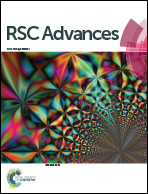Preparation and adsorption capacity of porous MoS2 nanosheets†
Abstract
Layered porous MoS2 with high adsorption capacity was synthesized directly using molybdenum trioxide and potassium rhodanate as Mo and S sources in a facile hydrothermal method without any surfactant and sacrificial template. The influences of varying the hydrothermal temperature on the morphology and adsorptive properties of MoS2 are discussed. As-prepared MoS2 samples were characterized by X-ray diffraction (XRD), X-ray photoelectron spectroscopy (XPS), field-emission scanning electron microscopy (SEM), transmission electron microscopy (TEM), ultraviolet-visible spectrophotometry (UV-Vis), room-temperature photoluminescence spectroscopy (RT-PL), thermogravimetric analysis (TGA) and Brunauer–Emmet–Teller (BET) measurements. MoS2 samples exhibited an optimal nanostructure, specific surface area and thermal stability when the hydrothermal temperature was 190 °C, and the layered porous structure is comprised of many thin nanosheets. In addition, the final adsorption capacities of the layered MoS2 toward RhB, MB and MO were studied. The sample exhibited ultrafast adsorption for dye removal and could reach 163.0 mg g−1, 499.0 mg g−1 and 125.1 mg g−1 at 420 min, respectively. The adsorption mechanism was also studied. The results indicate that layered MoS2 structures possess a significant adsorption ability, which may be useful for further research and practical applications of the layered MoS2 adsorbent in wastewater treatment.


 Please wait while we load your content...
Please wait while we load your content...